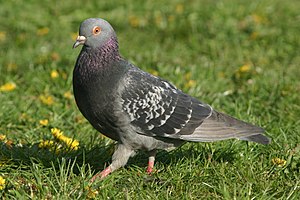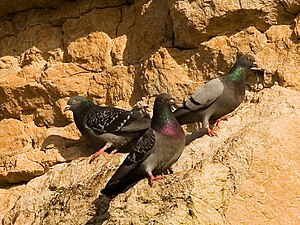Difference between revisions of "Field Guide/Birds/Columba livia"
(dewikify) |
m (| level = 4) |
||
| Line 2: | Line 2: | ||
| name = Rock Pigeon | | name = Rock Pigeon | ||
| latin_name = Columba livia | | latin_name = Columba livia | ||
| + | | level = 4 | ||
| image_1 = Strutting pigeon.gk.jpg | | image_1 = Strutting pigeon.gk.jpg | ||
| caption_1 = Rock Pigeon near the shore in Connecticut | | caption_1 = Rock Pigeon near the shore in Connecticut | ||
Revision as of 01:42, 28 March 2007
| Columba livia (Rock Pigeon) | |
|---|---|
| Description | |
| The Rock Pigeon (Columba livia), is a member of the bird family Columbidae, doves and pigeons. The bird is also known by the names of feral pigeon or domestic pigeon. In common usage, this bird is often simply referred to as the "pigeon". The species was commonly known as Rock Dove until the British Ornithologists' Union and the American Ornithologists' Union changed the official English name of the bird in their regions to Rock Pigeon.
The Rock Pigeon has a restricted natural resident range in western and southern Europe, North Africa, and into South Asia. Its habitat is natural cliffs, usually on coasts. Its domesticated form, the feral pigeon, has been widely introduced elsewhere, and is common, especially in cities, over much of the world. In Britain, Ireland, and much of its former range, the Rock Pigeon probably only occurs pure in the most remote areas. A Rock Pigeon's life span is anywhere from 3-5 years in the wild to 15 years in captivity, though longer-lived specimens have been reported. The Rock Pigeon is 30-35 cm long with a 62-68 cm wingspan. The white lower back of the pure Rock Pigeon is its best identification character, but the two black bars on its pale grey wings are also distinctive. The tail is margined with white. It is strong and quick on the wing, dashing out from sea caves, flying low over the water, its white rump showing well from above. The head and neck of the mature bird are a darker blue-grey than the back and wings; the lower back is white. The green and lilac or purple patch on the side of the neck is larger than that of the Stock Dove, and the tail is more distinctly banded. Young birds show little luster and are duller. Eye color of the pigeon is generally orange but a few pigeons may have white-grey eyes. The eyelids are orange and are encapsulated in a grey-white eye ring. Feet are red to pink. When circling overhead, the white under wing of the bird becomes conspicuous. In its flight, behavior, and voice, which is more of a dovecot coo than the phrase of the Wood Pigeon, it is a typical pigeon. Although it is a relatively strong flier, it also glides frequently, holding its wings in a very pronounced V shape as it does. Though fields are visited for grain and green food, it is nowhere so plentiful as to be a pest. The nest is usually on a ledge in a cave; it is a slight structure of grass, heather, or seaweed. Like most pigeons it lays two white eggs. The eggs are incubated by both parents for about 18 days. The nestling has pale yellow down and a flesh-coloured bill with a dark band. It is tended and fed on "crop milk" like other doves. The fledging period is 30 days. | |


